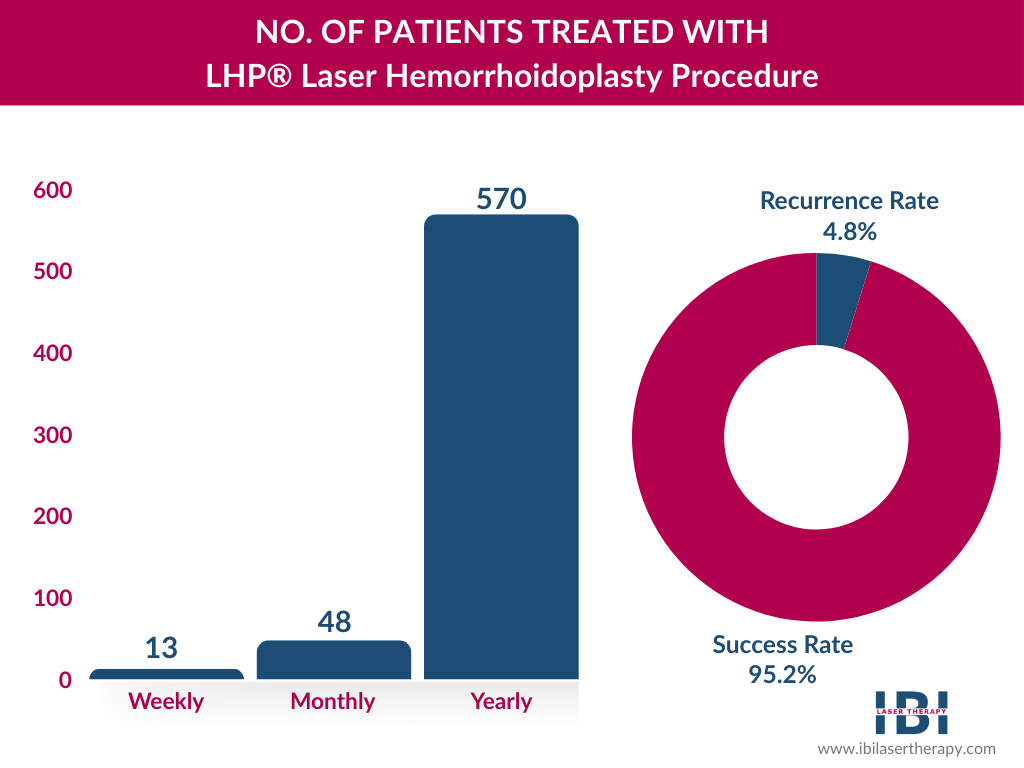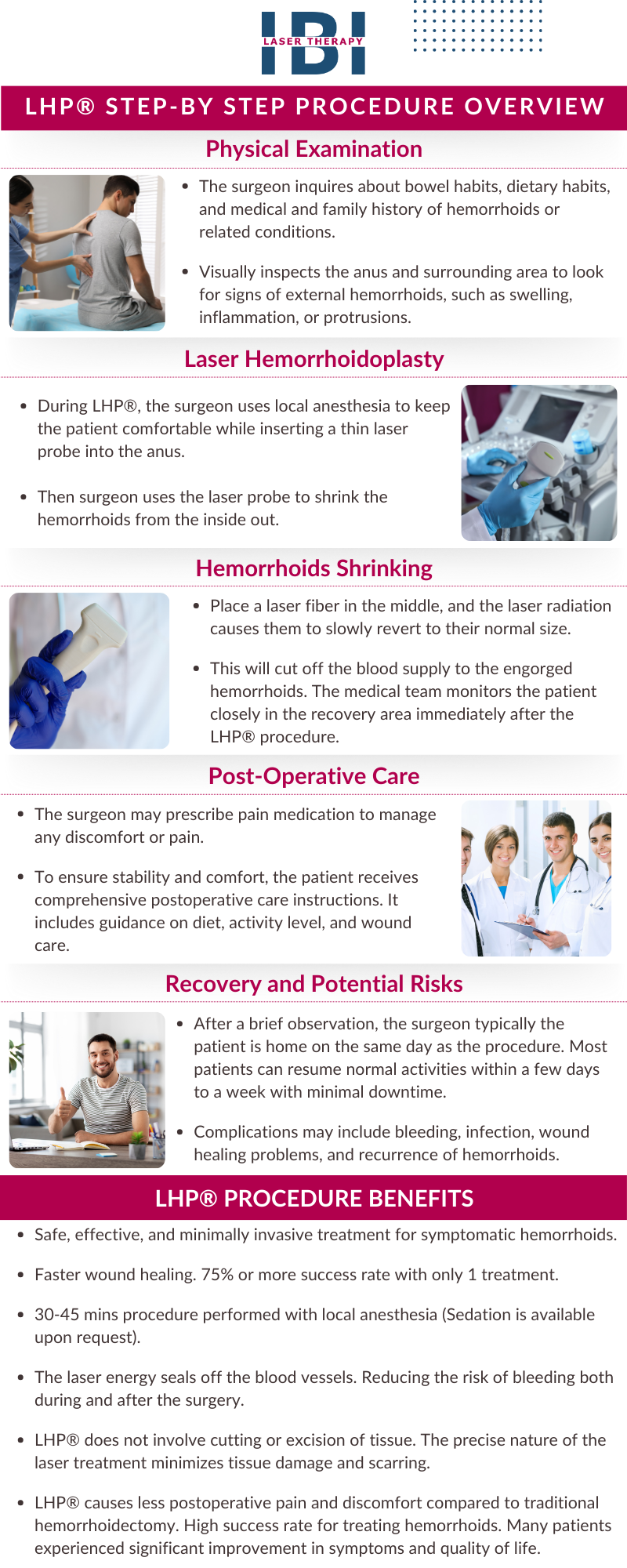Hemorrhoids Treatment LHP®
- Home
- /
- Our Services
- /
- LHP® Laser Hemorrhoidoplasty
Hemorrhoids and Hernia Overview
Particularly, swollen and inflamed veins in the rectum and anus as hemorrhoids or piles. Generally, they can be internal (inside the rectum) or external (under the skin around the anus). Additionally, it causes discomfort, pain, itching, and bleeding, particularly during bowel movements. Common causes include straining during bowel movements, chronic constipation or diarrhea, pregnancy, and obesity. To begin with, treatment options for hemorrhoids include lifestyle modifications, over-the-counter medications, topical treatments, and in severe cases, surgical procedures.
On the other hand, a hernia occurs when an organ or tissue protrudes through a weak spot. In short, the tear in the muscle wall that surrounds it. As a rule, hernias can develop in the abdomen. Including ventral hernia, umbilical hernia, groin (inguinal hernia), and upper thigh (femoral hernia). Common symptoms include a bulge or lump in the affected area, discomfort, or pain, especially when lifting or straining. One important, risk factors include obesity, heavy lifting, chronic coughing or straining, pregnancy, and previous abdominal surgery. In brief, treatment for hernias typically involves surgery. To repair the muscle weakness and close the opening in the muscle wall.
Difference Between Hemorrhoids Treatment and Hernia Repair Procedure
When it comes to gastrointestinal health, it’s equally important to distinguish and understand the difference between Hernia and Hemorrhoids. Both tend to cause discomfort, but they are distinct.
- Location
- Primarily, hemorrhoids affect the veins in the rectum and anus. While hernias involve the protrusion of organs or tissues through a weakness in the muscle wall. Particularly in the abdomen or groin.
- Primarily, hemorrhoids affect the veins in the rectum and anus. While hernias involve the protrusion of organs or tissues through a weakness in the muscle wall. Particularly in the abdomen or groin.
- Symptoms
- Hemorrhoids commonly cause itching, pain, and bleeding during bowel movements. Whereas hernias often present as a visible bulge or lump in the affected area. Along with discomfort or pain, particularly when straining.
- Hemorrhoids commonly cause itching, pain, and bleeding during bowel movements. Whereas hernias often present as a visible bulge or lump in the affected area. Along with discomfort or pain, particularly when straining.
- Causes
- Factors such as chronic constipation, pregnancy, and obesity often cause hemorrhoids. On the other hand, hernias can develop due to muscle weakness from factors like heavy lifting, chronic coughing, or pregnancy.
Types of Hemorrhoids
In summary, we treat a range of internal and external hemorrhoids. To illustrate, hemorrhoids treatment are classified into two main types based on their location and severity:
Internal Hemorrhoids
Internal hemorrhoids develop inside the rectum. Whereas, there are fewer pain-sensing nerves, making them less likely to cause pain. Additionally, these hemorrhoids may protrude or prolapse through the anus. During bowel movements, leading to discomfort, bleeding, and irritation.
External Hemorrhoids
External hemorrhoids develop under the skin around the anus. Oftenly, more painful and noticeable than internal hemorrhoids. Furthermore, these hemorrhoids can form blood clots (thrombosis). Eventually, leading to severe pain, itching, discomfort, swelling, and irritation in the effected area.
Hemorrhoids Causes and Risk Factors
Complications of Hemorrhoids if Left Untreated
Unquestionably, hemorrhoids if left untreated. Some medical conditions can lead to serious complications. However, that may be challenging to manage. Early diagnosis and proper treatment help manage it further advancing to severe stages.
Hemorrhoids Signs, Symptoms and Complications
Signs
- Rectal Bleeding.
- Pain While Sitting.
- Pain or Discomfort.
- Protrusion or Lump.
- Swelling or Leakage.
- Infection or Mucus Discharge.
Symptoms
- Itching or Irritation.
- Sensitivity or Tenderness.
- Painful Bowel Movements.
- Incomplete Bowel Movements.
- Weakness or Fatigue.
- Iron Deficiency, or Pale Skin.
Complications
- Strangulation.
- Prolapse (Internal Hemorrhoids).
- Thrombosis (External Hemorrhoids).
- Cellulitis, or Abscess Formation.
Hemorrhoids Available Treatments
Actually, surgeons can often manage hemorrhoids effectively with various treatment approaches. Such as surgical and non-surgical options. The treatment depends on the severity of symptoms, the type of hemorrhoids, and the patient’s overall health. To sum up, here are the common treatment options:
Topical Medications
Over-the-counter creams, or ointments containing hydrocortisone, witch hazel, or numbing agents. After all, they can relieve itching, pain, and inflammation. Effective providing temporary relief.
Hemorrhoidopexy (Stapled)
The procedure involves using a special stapling device to remove excess tissue. Eventually, reposition hemorrhoids back into their normal position. A minimally invasive alternative to traditional hemorrhoidectomy.
Sclerotherapy
Injection of a chemical solution into internal hemorrhoids. Eventually shrink them by causing scarring and reducing blood flow. To sum up, effective for treating smaller internal hemorrhoids.
Hemorrhoid Banding/Ligation
The procedure involves placing a small rubber band at the base of the hemorrhoids. Finally, it cut off blood flow, causing them to shrink. Minimally invasive, outpatient procedure for treating internal hemorrhoids.
Hemorrhoidectomy
The surgical procedure removes, particularly, large and severe symptomatic internal or external hemorrhoids. In addition to this, provides long-term relief. But may require a longer recovery time.
LHP® Laser Hemorrhoidoplasty
The laser procedure shrink hemorrhoidal tissue, reducing symptoms. Minimally invasive, outpatient procedure with reduced postoperative pain and faster recovery compared to traditional surgeries.
Non-Surgical Hemorrhoids Treatment
Firstly, LHP® treats hemorrhoids without traditional procedure risks or prolonged recovery. Secondly, the operative time is much shorter than surgical hemorrhoid treatment. Lastly, the procedure does not involve cutting or removing any tissue. The laser treatment cuts off the blood supply so hemorrhoids can no longer protrude.

LHP® Laser Hemorrhoidoplasty
Nonetheless, at IBI Laser Institute, surgeons strategically target to prevent damage to the anoderm, sphincter, or mucous membranes. Besides this, here’s our step-by-step LHP® procedure overview to treat internal or external hemorrhoids successfully:

Patient Testimonial
LHP® Hemorrhoids Treatment Cost, and Insurance Coverage
On the whole, the average cost of the LHP® procedure typically ranges from around $6,500 and $10,000 per session. However, the extent of hemorrhoidal tissue involvement and the severity of symptoms can influence the overall procedure cost. Equally important, IBI Laser Institute currently has a promotional campaign. Because of this, we are offering the LHP® Laser Hemorrhoidoplasty procedure at a special price. To repeat, it is subject to a limited period.
In reality, healthcare providers consider the LHP® procedure a medical necessity for treating symptomatic hemorrhoids in many cases. Although, some health insurance plans may offer partial or full coverage.
Nevertheless, we also help patients. In fact, our financing options include CareCredit and Prosper Lending to manage the cost of the procedure. Undoubtedly, Our patient experience team helped many patients to determine their insurance coverage eligibility. In any event, call us to inquire more about insurance or flexible financing options.
